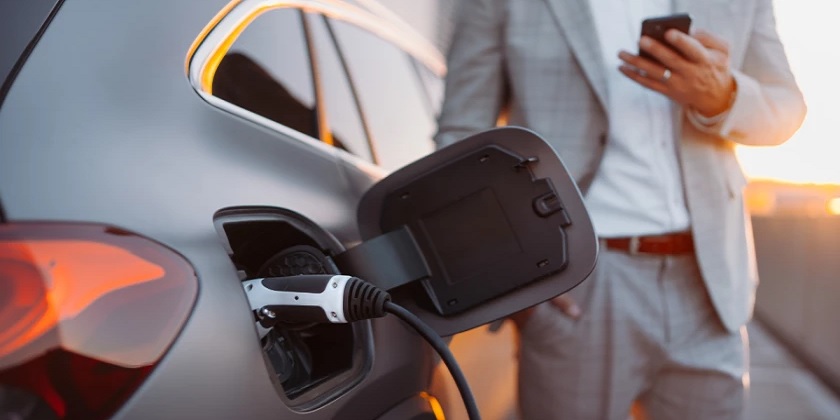How to prevent electric vehicle range anxiety in government fleets

Range anxiety is a real concern for government fleet drivers. Despite the benefits of EVs in reducing emissions, drivers still worry about fear of running out of battery power and lack of access to charging stations.
This fear of getting stranded or stuck somewhere waiting for vehicles to recharge presents psychological barriers to adoption. Government fleet managers must address these concerns to help fleet drivers overcome them.
Preventing electric vehicle range anxiety
Preventing range anxiety starts with educating your workforce about the realities of EVs.
Fleet driver education
The average fleet vehicle drives about sixty-five miles daily, while the average EV gets 291 miles per charge. As long as EVs are charged every few days, they should have ample power to handle most tasks within geographic locations.
New advances in technology are also changing perceptions. For example, Toyota has announced a new battery that promises a 745-mile range and a stunning ten-minute recharge. Such advancements can reduce EV range anxiety.
Fleet drivers also need to know that there’s been a significant increase in charging infrastructure. At the beginning of 2023, there were more than 2.7 million public charging stations—a 55% increase from the year before. Educating fleet drivers about public charging locations and government charging locations can help ease concerns.
Fleet driver experience
By phasing in acquisitions, fleet managers can reduce EV range anxiety. As fleet drivers see others using EVs without problems, they become more comfortable with the transition. Studies show that EV range anxiety fades quickly as experience with the vehicles increases.
You can also enhance the driver experience by making sure you are right-sizing vehicles for tasks—for example, managing fleet assignments based on mileage to reduce concerns and maintaining internal combustion engine (ICE) vehicles for longer or more demanding trips.
Technology plays a role in overcoming driver concerns. For example:
- Utilizing route planning software to maximize routing lets fleet drivers know in advance how many miles they should expect to drive and limits unnecessary routes.
- Route tracking can analyze projected routes to monitor range and battery levels in real time, providing ample notifications when the range is lower than expected.
- Vehicle telematics can continuously monitor battery and engine health, providing automated alerts to drivers and fleet managers when conditions change.
- Intelligent battery management systems monitor battery conditions and can automatically adjust to environmental factors that affect the cells to enhance battery lifespans.
Incorporating regular preventative maintenance into your EV programs and ensuring that drivers are aware of what you’re doing can also help.
Proper charging infrastructure
The biggest way to help overcome EV range anxiety is to ensure that a proper charging infrastructure is available. When fleet drivers know that they can easily find a charging station during their travels, their concerns often fade.
Since most government fleet vehicles tend to travel with a small geographic footprint, many vehicles will return to their home bases for charging. Charging can take place overnight, so the EVs always have a full charge when drivers use them. This eliminates a common complaint from fleet drivers of ICE vehicles, especially in multi-use vehicles, where drivers find that the last user failed to fill the tank.
Case studies: Lessons learned
Fleet managers can learn from what their counterparts did in transitioning fleets to electrification. Here are a few case studies that may provide insight.
Charlotte, North Carolina’s municipal fleet electrification program included fleet right-sizing and route optimization from the start, using telematics to model business cases and identify the best candidate vehicles for replacement. Cincinnati, Ohio, municipal fleet managers also carefully examined use cases, opting to phase in operations with light-duty vehicles and delay adding medium- and heavy-duty vehicles, which consume more power, until range anxiety concerns faded.
When FedEx Express moved to EVs, it limited use to urban areas that had low variability and put maximum daily mileage caps on distances. The Massachusetts pilot program for battery electric buses in three school districts used the same philosophy, phasing in electric buses first in predictable routes and helping ease range anxiety, especially in cold weather climates.
The city of Chula Vista, California, adopted the mantra, “fleet follows facilities,” prioritizing the charging infrastructure and ensuring that fleet drivers had easy access to charging stations before procuring EVs.
The state of Vermont commissioned studies to determine best use cases and detail the improvements in the quality of life for residents, from eliminating tailpipe emissions to reducing noise, helping fleet drivers understand that the transition to EVs was making a positive difference.
Conclusion
Government fleet managers can significantly reduce EV range anxiety by properly educating fleet drivers, phasing in EV acquisition to expand experience levels, and ensuring that proper EV charging infrastructure is in place before widespread procurement.
See how easy it is to get the EV fleet you need without the hassle, using Sourcewell’s cooperative purchasing program. Streamline the public procurement process by choosing from hundreds of suppliers already on contract. Sourcewell’s procurement experts competitively solicit and award contracts on behalf of 50,000 participating agencies in North America. Check out our EV contracts and more for free here.


